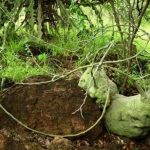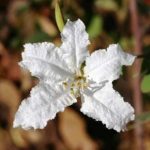TREE LIFE
JULY 2001
SUBS ($200) WERE DUE ON 1ST APRIL. PLEASE USE THE INVOICE ATTACHED TO THE APRIL TREE LIFE WHEN MAKING PAYMENT,
MASHONALAND CALENDAR
Saturday 7 July Botanic Garden Walk – meet in the car park of the Botanic Garden at 10.45 for 11 am. where we will meet Tom and continue with the Kalahari sand/jesse topic.
Sunday 15 July. The Watson-Smith family in the Beatrice farming area will be our hosts this month. Of particular interest will be Terminalia brachystemma, Strychnos pungensandCombretum imberbein very pleasant woodland. Our last visit to Alamein Farm was in June 1987.
Saturday 28 July Mark’s next walk will be at the Greystone Park Nature Reserve. We will meet at 2.30 pm.
Saturday 4 August Botanic Garden Walk
MATABELELAND CALENDAR
Because of the fuel situation no meetings have been scheduled. but should things improve phone Jonathan Timberlake.
GUITINGWOOD, BINDURA: 18 MARCH 2001
The extraordinary, heavy rains which have affected the northern half of the country this season almost caused the outing to be cancelled. Indeed, in the days before, with the Mazowe River up over the low-level bridge, there were a number of anxious phone calls. However, on the morning of the 18th, early, John Cottrill himself checked the river and reported that all was well, as luckily it still was when we crossed it twice later that day.
As if to demonstrate that low-level bridges are not to be taken lightly, there, just downstream of the bridge, was the front end of an articulated truck sticking up out of the swirling waters. Although we couldn’t see them, also apparently the trailer and its load were down there.
Our hosts were John and Lillian Cottrill. Close to their home is a magnificent rocky kopje, consisting of enormous piled up rocks, with a splendid native flora, to which John has added a considerable number of interesting planted species. The whole area was extraordinarily wet, a very striking contrast to previous visits when it was markedly dry. An important point to remember is that the altitude is fairly low, 1080 m (3540 ft) and as always this had its effect on the type of trees seen.
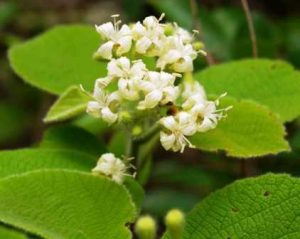
Cordia pilosissima. Photo: Meg Coates Palgrave. Source: Flora of Zimbabwe
On the path towards the kopje, John has planted two species of Cordia, namely C. pilosissima (Woolly cordia) and C. africana (the large-leaved cordia, formerly known as C. abyssinica). The genus itself is generally placed in the family Boraginaceae, which has relatively few woody species – only Ehretia and Cordia with us; mostly the species are herbaceous with often hispid hairs.
- pilosissima occurs at lower altitudes in the Zambezi valley; it has very broad to almost circular leaves with a rounded apex, which are shortly and densely hairy. C. africana, which is also a low altitude species, has a much more scattered distribution has leaves which are broadly ovate with an acute apex.
Close by these trees were two herbaceous species of Senna. The commoner of the two is Senna occidentalis (Coffee senna). This is a pantropical weed, probably originating from America. In Zimbabwe it is a low to medium altitude species, usually occurring in disturbed ground; its leaflets have a distinctly acute apex. S. obtusifolia (American sicklepod), as the specific name implies, has leaves with a more rounded apex. It is also a pantropical weed and also favours low altitudes with us, also in disturbed places and often growing with the previous sp. One of its favourite habitats is to colonise sandy river beds.
Near the base of the kopje, John had planted Bridelia micrantha (the Mitzeerie), which appeared to be doing well. Like all Euphorbiaceae, the flowers are unisexual and according to the books in this case both male and female occur on the same tree. The species prefers higher rainfall areas and is commonest in the Eastern districts. Nearby was a marula, which I would have expected to occur naturally in this area, but I gather does not.
Also nearby were planted specimens of Strophanthus kombe, Tamarindus indica, Calpurnia aurea and Cladostemon kirkii. From this point on, in the rather shady conditions prevailing, there was quite a distinctive native flora dominated by Oplismenus burmannii, an annual grass with broad leaves and sticky awns. The genus itself is one of forest conditions, usually montane or riverine, and O. burmannii has found itself a niche in the shady parts of suburban gardens in Harare.
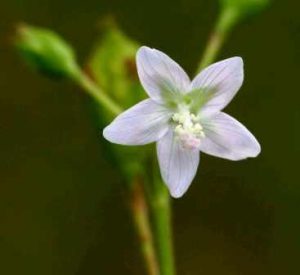
Hibiscus lobatus. Photo: Bart Wursten. Source: Flora of Zimbabwe
Also present was Bidens biternata with its tiny yellow ray florets and, most interesting, the white flowers of Hibiscus lobatus. This has very variably lobed leaves, but its most interesting feature is that it has no epicalyx. This is very unusual in Hibiscus – all the other Zimbabwean ones have it except for the slender yellow-flowered H. sidiformis.
A little further on, in shady humus-filled areas between the rocks, John showed us the leaves of an arum, Amorphophallus abyssinicus. This produces its flowers early in the season (but we were too late for those) and the leaves appear later. The fruits are red. Later, in a similar habitat, we came across the hastate leaves of another arum – Stylochaeton puberulus.
Also amongst the humus pockets were large plants of a true stinging nettle, Girardinia diversifolia of the family Urticaceae. Some of us were stung by this plant during the morning – after initially being a bit painful, the sting seemed to fade fairly quickly. Not all stinging plants in Zimbabwe belong to the Urticaceae – the main exception being the species of Tragia which are often sprawling or climbing and rather urticaceous in appearance but which actually belong to the Euphorbiaceae.
Near to the “cave” was a fine example of Allophylus africanus, which enabled comparison with those species of Rhus with toothed leaves to be made. Maureen pointed out the typical bark which is rough with pieces flaking off upwards. In the cave, I collected a small fern, later identified as Doryopteris kirkii.
Further on round the kopje, John showed us a planted Garcinia livingstonei. This is a low-veld species, unlike the more usual Garcinia buchananii we see on our outings around Harare. Both species have yellow sap, which in both cases is best seen by folding one of the rather brittle leaves in half whereupon the sap oozes out along the line of the crack. A further differentiating feature is that the leaves are in whorls of 3 in livingstonei and opposite in buchananii.
Nearby was Strychnos potatorum. Someone asked what “potatorum” meant – it is indeed a genitive plural and it means “of drinkers”. Is this related to the fact that its fruits are said variously to purify or poison water?
At this point the party entered an almost flooded part of the walk. Most bravely continued and were rewarded with wet feet. Here were the furry leaves of Albizia versicolor, the peeling trunks of Commiphora marlothii, the glossy leaves in whorls of Rauvolfia caffra and a rather local climbing composite Solanecio angulatus.
Climbing out of the wet area, John showed us a Ficus natalensis which had a wide network of stems and roots spread across some rocks. All over the roots were slashes which had been caused by local people obtaining the latex, which is said to improve lactation.
After lunch under the veranda and in shady places around the garden, there was a distinct lack of energy for anything adventurous and the party contented itself with a gentle stroll around the garden, looking at Johns’ water-lily ponds.
One plant of interest was the water-plantain, Alisma plantago-aquatica. This has an open, branched, pyramidal inflorescence with tiny white flowers. It is a common species by European streams and ponds. Interestingly, this family has milky latex – which was confirmed by this plant.
All in all, a marvellous day and our thanks go to John and Lillian for their hospitality. Congratulations also to John for achieving his 80th birthday – actually just a few days after our visit.
Finally, a plea for more people to write up our outings. One of the great strengths of the Society is its regular monthly outing and the record which appears soon after in Tree Life. In case anyone feels that they are not expert enough, please do remember that there are many ways of tackling write-ups – for example, more emphasis could be placed on people rather than plants, or on the uses of plants. It does not need to be all Latin. I am sure that any committee member would be very glad to assist with any technical queries.
-MAHyde
CHIMANIMANI: OUTWARD BOUND: 13-18 APRIL 2001
This long, combined Easter and Independence weekend drew a larger than usual number (c.24) of members to Outward Bound in the Chimanimani mountains.
FRIDAY 13 APRIL (Good Friday)
The journey down (and back) took on an epic flavour as all the members planned and schemed to ensure that they would have sufficient fuel. The Hydes and Harwins decided that the landcruiser, with its large tanks, could just make it there and back without filling up if we did nothing else. So, early on Friday morning, we piled cases high on the roof rack and newspapers for plants into the car. Then we found corners in the pint pot for the actual bodies.
Along the road we stopped at every station for fuel. Nothing was found until Rusape and then only petrol. We consoled ourselves that most members would probably have petrol vehicles.
It has been nearly 10 years since the Society visited Outward Bound in August 1991 and in many ways it was broadly as I remembered it. The general layout of the buildings is the same but some of the surrounding areas (e.g. the walk to Tessa’s Pool) had become more scrub-like whereas I remember them as grassland. I had forgotten how very tall and imposing the surrounding bare mountains are.
SATURDAY 14 APRIL
The general vegetation on the hills around Outward Bound consists of Brachystegia and Uapaca woodland (although the actual species seen were not exactly the same as they would have been around, say, Harare). The rainfall is high and the altitude is quite low (c.1100 m) and these two facts characterise a lot of the vegetation seen. We were there after what was said to have been an abnormally wet season and certainly I have never seen such spectacular long-pendulous grey-green curtains of lichen which were very plentiful on the trees. Epiphytes such as ferns, orchids and peperomias were also common.
Other habitats included some evergreen forest around Tessa’s Pool, presumably riverine, which was of great interest. Just below Tessa’s Pool is a wide vlei, which is not a very common habitat in the Eastern Districts. There were also areas of scrub and grassland, containing such species as bracken, Smilax and small shrubs. A further factor in understanding the flora is that species endemic to the Chimanimani mountains begin c.100 metres east of Outward Bound.
The first morning was a local walk in which, much to the amusement of the non-botanists, we took 3 hours to walk to Tessa’s Pool. In fact, this wasn’t really long enough as we didn’t have quite enough time to study the trees around and Tessa’s Pool in sufficient detail!
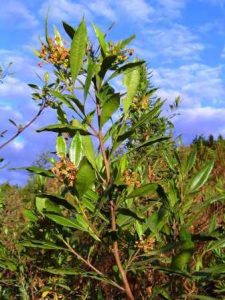
Dodonaea angustifolia. Photo: Petra Ballings. Source: Flora of Zimbabwe
The first part took us through scrubby vegetation with species not unlike those we see in savannah conditions – Dodonaea angustifolia (Sand olive), Psorospermum febrifugum(Christmas berry), Strychnos spinosa. Also present was the common, stout, coarse, tussocky grass which is so common in the Eastern Highlands, namely Eragrostis acraea. In addition to eastern Zimbabwe, it also occurs (a remarkable record!) on one of the outliers, namely what used to be called Besna Kobila in the E Matopos and also outside Zimbabwe in the E Transvaal. Also present was the prickly climber, Smilax kraussiana, which so often makes walking in the eastern districts nothing to smile about. The plant, perhaps surprisingly, is a monocotyledon and is somewhat related to the lily family. Modern opinion appears to put in the Smilacaceae or, sometimes the Philesiaceae. It has flowers in umbels and broad leaves.
On beginning to descend slowly the path to Tessa’s Pool we entered some open Brachystegia woodland. We found this genus rather puzzling and I am not sure we really understood everything we were seeing. Certainly, there was Brachystegia spiciformis (with more leaflets than usual as is often the case in the east). We also found Brachystegia microphylla (Small-leaved brachystegia) with its very large number of leaflets (25-55 pairs per Coates Palgrave) and there were also numerous intermediates with intermediate numbers of leaflets. However, I must admit to some confusion as to whether Brachystegia glaucescens occurred and how precisely it differed from microphylla and the various spiciformis/ microphylla intermediates.
Also in the scrub was Monotes engleri (Pink-fruited monotes). This is the slightly rarer one of the pair of woodland monotes and has strongly discolorous leaves which are green above and greyish beneath. A plant we don’t often see is Annona senegalensis (Wild custard-apple). This is usually a shrub and has large slightly greyish leaves, which smell aromatic when crushed. It is very much a plant of lower altitudes, usually in high rainfall areas.
As we approached Tessa’ Pool, some of the very exciting species, typical of mid-lower altitude forest, appeared. For a start, a very large Newtonia buchananii (Forest newtonia) overhangs the pool. Shrubs of Englerophytum magalismontanum (Stem fruit) occur in the understorey – this is of course a species of much higher altitudes as well.
One of the interesting features of the Zimbabwean flora is how within a genus there are species which occur in savannah woodland and often one which occurs in forests. The latter usually has glossy, evergreen leaves with a drip-tip. Two examples of this feature were seen at Tessa’s Pool.
In the genus Garcinia, we have the forest species, Garcinia kingaensis (Northern forest Garcinia). This has dark green, thick leaves with a prominent apex. The two savannah species are the highveld Garcinia buchananii (Granite garcinia) and Garcinia livingstonei (African mangosteen). All three species have yellow latex, best seen by folding a leaf transversely so that it cracks, whereupon yellow globules appear along the crack. Incidentally, Garcinia livingstonei differs in having leaves in whorls of 3, whereas the other two have mainly paired leaves.
The second example was (Red hook-berry), which is a glossy-leaved equivalent of the more familiar, riverine Artabotrys monteiroae orArtabotrys brachypetalus. Both species are climbers and both have the strange-shaped hooks which are formed from the stalks of the inflorescence.
- Further riverine species seen included Breonadia salicina (Matumi). A quick check was made that it produced no milk in order to confirm it was not Rauvolfia caffra, although spherical inflorescences were also seen which make it even more certain. Also a rather unusual shrub in the Apocynaceae, namely Mascarenhasia arboresecens. The latter has milky juice and rather prominent paired pods.
The hardier members swam in the refreshing chill of Tessa’s pool before returning to Outward Bound for a relaxing afternoon. The weather on this day was practically perfect with nearly continuous sun in a striking clear atmosphere with startlingly good visibility.
In the afternoon, a smaller party walked a short way to the east of Outward Bound and soon found ourselves in the country of endemics. We saw, as in 1991, a large species of Aeschynomene, probably grandistipulata. It is a legume with orange-yellow flowers, slightly glaucous foliage with large leaflets and, as the name suggests, large stipules. Also seen was the Shell-leaf, Hemizygia flabellifolia, another endemic to the Chimanimani mountains. This has recently been renamed Syncolostemon flabellifolius.
The evening was spent with a hilarious drawing game suggested by Eva. It was a sort of artistic version of whispering a message down a long line of people and finding something different emerge at the end.
-MAHyde
SUNDAY 15 APRIL
The plan for this day was to walk back out along the road to Outward Bound until we came to the Haroni River, have lunch and then return along the river. This is pretty much how it turned out, although again staff at Outward Bound were astounded at how long it took us to get to the gate. Once again, the sun shone brilliantly through the azure skies.
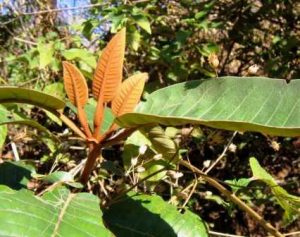
Harungana madagascariensis. Photo: Stefaan Dondeyne. Source: Flora of Zimbabwe
The first part of the walk took us though scrub with isolated larger trees and occasionally stands of evergreen, riverine trees as the road crossed various rivers. The three species carefully learnt by Linda the day before (Harungana madagascariensis, the Praying hands bush, Toddalia asiatica with its “naartje berries” and the large-leaved Annona senegalensis) presented themselves for revision.
The shrubs seen included Otholobium foliosum, which is a legume with 3-foliolate leaves which are gland-dotted and purple flowers. It is a species of high rainfall areas, occurring mainly in the eastern highlands, although there is an isolated and rather strange record from Devedzo Hills near Rusape. A visit is needed one day to check on that locality.
Here also were the purple flowers and golden fruits of the Buffalo Bean (Mucuna sp.). A shrub which is rather local on rocky hills and in high rainfall areas along the watershed is Solanecio mannii (Crassocephalum mannii – the Canary-creeper tree); this has leaves clustered near the stem apices with numerous leaf scars and (at the right time of year) strongly unpleasant-smelling flowers.
In the shade at one point was Peddiea africana, with its glossy leaves and green (sometimes tinged with red) flowers in small umbels. The identity of the Peddiea can be confirmed by breaking off a piece. This never breaks cleanly but strips off down the branch. Its family is Thymelaeaceae, a smallish family in Zimbabwe, which includes such cultivated species as Daphne, which Peddiea clearly resembles.
Where the road crossed the Hadange River, a different flora came in, composed of evergreen woody species. We puzzled over a medium-sized tree with glossy pinnate leaves and spherical fruits. The latter had striking red seeds with a yellow aril at the base. Eventually, we decided it was Bersama swynnertonii (Purple bersama). Also by the stream were more specimens of Breonadia, the palm Phoenix reclinata, Schefflera umbellifera (Forest false cabbage tree), a Syzygium and the distinctive hooks of Artabotrys monteiroae. In the trees climbed a species of Landolphia with its spherical fruits.
The road then took us through more open bush, a lot of it somewhat disturbed by man and mombes, which included the red-flowered Bauhinia galpinii, the climbing Mussaenda arcuata with its yellow flowers, a climbing Clematis, which is unidentified as yet, and Embelia schimperi, also a climber which, like Rapanea in the same family, has glandular translucent streaks in its leaves. Various weeds with a low altitude component were present – specifically Senna occidentalis (Coffee senna).
Finally, we arrived at the Haroni and met up with Pippa Browne who had kindly backpacked our lunch to us (taking about 15 minutes to do what had taken us 3 hours). After lunch we returned along the Haroni. There was some excitement here as we removed our shoes and socks in order to cross the slightly swollen Hadange river, but all too soon we were back at Outward Bound.
MARK AND LINDA HYDE
MONDAY 16 HARDANGE VALLEY
The third day of our visit dawned with the mountains shrouded in mist and the weather outlook uncertain. We had a hearty breakfast of oatmeal porridge and fried egg and bacon, prepared our picnic lunch in the kitchen, and set off up the Hardange Valley with Phillipa to show us the way. The Hardange is a tributary of the Haroni that runs down from the mountains to the south of the Centre. William, Eva and three of the boys left before us with the intention of climbing to the top of the mountains. We were joined this day by the Buttress and Jackson parties from Marondera.
The first part of the walk led through mixed woodland and over a rocky ridge dotted with stunted trees festooned with old man’s beard lichen over 1 m long. Ericaspp. grew in between the trees, and the stony ground was carpeted with mosses, while the rocks were spattered with orange and white lichens. Mark showed us some very unusual plants. Aeschynomene grandistipulata is a shrub endemic to the area and common around the Centre. It has pale green, fleshy, pinnate leaves, with the leaflets set at an angle to the plane of the rachis, and takes its specific name from the leaf-shaped stipules that are bigger than the leaflets themselves. The flowers are orange and pea-like. It was too early for the fruit, which in this genus is said to resemble a row of false teeth. Rhipsalis baccifera, Zimbabwe’s only indigenous species of cactus, was growing in a tree at a fork in the path. It has long, branching, green stems, far removed from what one would imagine a cactus to be. Two rather insignificant Chimanimani-endemic herbs seen were a subspecies of Otiofera inyangana, with flattened ericoid leaves and small, pale pink, star-shaped flowers, and Thesium chimanimaniensis, with thin, branching, green stems.
We descended the other side of the ridge and crossed the Hardange River on a narrow wooden suspension bridge. The path led through grassland among small clumps of trees, including an unidentified species of Indigofera with red flowers rising above its spreading branches. Then we climbed on a slippery path into the National Park towards the mountains through tall Uapaca kirkiana forest. Harungana madagascariensis, easily recognisable by its “praying hands” terminal leaflets and its orange latex, and Maesa lanciolata, with its panicles of pale yellow flowers, made up the understory. Orchids grew in almost every tree, and on the ground we found blue-flowered Disotis, Gutenbergia andKotschya, mauve Lobeliaand yellow Anisopappusand Commelinaspp. Looking back, we had a spectacular view over Charleswood Farm to Chimanimani village on the skyline.
As we neared the base of the cliffs the path wound between huge rocks and the undergrowth became thicker and more luxuriant. Tangled masses of creepers, including a species of Hibiscus, the smaller but similar flowered Thunbergia alata (“Black-eyed Susas”), and Annelina, mingled with Pteridium aquilinum (bracken), while a variety of orchids, ferns and aloes grew on and among the rocks. We found small specimens of Xymalos monospora, a montane tree with characteristic quilted leaves, and tree ferns (Alsophila spp.) Red-leaved Hymenodictyon floribundum grew in crevices in the rocks. While the rest of the party climbed on, the keener botanists fretted over the identity of the Uapaca and Ficus that they encountered. While most of the Uapaca were clearly U. kirkiana, some had smaller, yellow-green leaves and longer petioles. Were they U. sansibarica, which we had identified with some confidence down by the Haroni? Some of the small figs growing on top of the rocks had concave ends to their leaves, while others had square ends. The former had to be Ficus craterostoma; were the others F. natalensis? Unfortunately for the Tree Society, taxonomy is not based on the character of leaves, and variation of leaf form within a species may be greater than variation between species. For practical purposes one must assume that similar trees growing in a similar habitat with a similar growth form are the same species, and identify the species by the dominant characteristics of the majority.
The dominant trees changed, from Uapaca to Brachystegia microphylla, as we clambered down to meet the river at the base of the gorge that brings it from the mountains. Unfortunately so too did the weather, as the rain set in, and our picnic lunch by the pools and rapids was hurried and uncomfortable. Jill was brave, or mad, enough to swim, and complained of the difficulty of dressing again into already wet clothes. The rest of the party took what shelter from the rain that they could find, swallowed their sandwiches, and beat a disorderly retreat down the mountain, slipping and sliding on the wet path back to the Centre for hot showers, dry clothes and hot tea. The mountaineers did not return until near nightfall, and did not appear to have enjoyed their descent from the top in the rain.
J.A.Lawrence
TUESDAY 17
The Tree Soc free reign of Outward Bound was shattered by the arrival of the multitudes for training courses. We were pleased to hear botanical terms used in their early morning briefing. At roll call we distinctly heard: ‘John here! Peter here! Philippia!’ They were warned: ‘Eulophia you get sent packing. Uapaca your bags and go straight home!’
For the Tree Soc the day started on a confusing note when John (of Borrowdale Donkey Stud fame) discovered in van Wyk & van Wyk a most unusual illustration of Ficus craterostoma which we are sure that we had seen the day before. So off we went down the hill and Gill came tumbling after. We sailed past a sign: Strictly No Public Access. Nice to have friends in high places. Traversing an area of Eragrostis acraea – the very coarse grass special to the east, yielded some good views of Eastern Saw-wing Psalidoprocne orientalis, Cape Batis Batis capensis, Augur Buzzard Buteo augur and the Phragmites australis reeds had a few roosting nests of the Thickbilled Weaver Amblyospiza abifrons.
We attempted to sort out the proteas on the hillside. P. petiolaris was distinct enough with the sicle shaped leaves tapering at the base to leave no room for a petiole. But to differentiate between P. caffra, P. angolense and P. gaguedi without flowers presented a problem. We were happy that bushes with multiple dead flower heads were P. welwitschii. The notice board at National Parks put the altitude at 1250 m.a.s.l. and so we saw some familiar friends like Combretum molle, Pterocarpus angolensis, P. rotundifolius and Steganotaenia araliacea. As the going got tough, the tough got going in the opposite direction and we returned through some brilliant Kniphofia sp. and Hypericum sp.
Lunch was a very leisurely affair at Middle Pool – a beautiful spot – again not accessible to the public. There was some energetic swimming by many of the Tree Soc but it was difficult to appreciate fully the delicate mauve Gladiolus overhanging the water whilst in freezing water.
The afternoon walk produced more that we had not seen. Trema orientalis, Ulmaceae, a pioneer species. Vangueria apiculata, Rubiacaea, leaves big,heavy and smooth. Rauvolfia caffra, Apocynaceae, with milky latex. Tabernaemontana ventricosa, smooth fruit. Mark entered a thicket and had his designer label shirt ripped by the spiny Smilax kraussiana, Toddalia asiatica and Diascoreasp. The latter showed both its methods of reproduction – three winged pods and an ‘air potato’ – like tuber. .A budding collector in seven year old Rebecca produced Perotis patens, bottle brush grass which, aparantly, we should know. Derek was off on a mission to collect a wood/charcoal sample of an Ozoroa for miscroscopic inspection which should clarify if it is the ‘wedding vow’ species. (Do you take….to be your awful dreaded spouse….insignis and in health).
With boggled minds we retired to the Out of Bounds Bar for some quaffing, yodling and good company. Many thanks to Pippa and all the group for such a wonderfull stay and to Mark for his endless patience with silly questions.
Sue, Dave, Michael and Robbie
WEDNESDAY 18 (Independence Day)
The last day and the day of departure for Harare. However, through Lyn Mullin, we had been invited to Lord and Lady Plunkett’s farm, Rathmore Estate, which lies not far off the road back towards the village of Chimanimani.
Here a warm welcome awaited us and we set off on a guided tour of an extensive wild garden. Streams flowed throughout the area, the vegetation was lush and the flora rich in both woody and herbaceous plants. The altitude (approximately 1500m) was much higher than Outward Bound and the trees and plants seen were rather different.
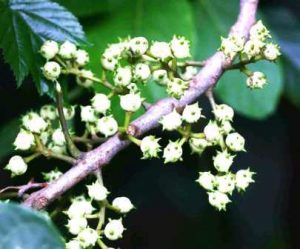
Macaranga mellifera. Photo: Bart Wursten. Source: Flora of Zimbabwe
The flora in fact was more like the trees one sees in the higher parts of the Vumba. Here were trees such as Macaranga mellifera (Mountain macaranga), Teclea nobilis (Small-fruited teclea), Myrica pilulifera (Broad-leaved waxberry), Rhamnus prinoides (Shiny leaf) and a species of Heteromorpha. Also very common was Choristylis rhamnoides (False shiny-leaf). Higher up were enormous trees of Albizia gummifera (Smooth-bark flat-crown), with their smooth trunks. Also present were Rauvolfia caffra, Trema orientalis and Solanecio mannii again.
Another typical Vumba plant seen was Xymalos monospora (Lemonwood). Although this is a fairly common eastern districts species, I don’t think it is very well known. The leaves are quite large and very variable in leaf lobing and are somewhat quilted with raised areas bounded by the looping veins. Furthermore, the leaves are often a mixture of opposite and alternate. The species belongs to the family Monimiaceae, which is a rather obscure one, at least in the context of Zimbabwe.
From Mabberley (The Plant Book), it appears the Monimiaceae (which has an amazing 440 species in the world) belongs to the order Magnoliales, along with other families such as Annonaceae, Canellaceae, Hernandiaceae and Lauraceae.
Finally, we reached a waterfall, at which spot a Giant lobelia had turned up one year. Was this Lobelia stricklandiae, I wonder? Unfortunately, there was no sign of it this year, although as the area is full of lush vegetation, it could still be around.
Quite apart from the woody flora, there was also an interesting herbaceous component, some of which were new to me and have not, as yet, been named. The morning ended with a very welcome light lunch provided by our hosts.
The return journey for us was uneventful. Although we could probably have made it back, we were very relieved to find diesel, and fill up, at the garage on the Mutare side of Christmas Pass.
Special thanks must go to Maureen who put in a lot of effort in organising the trip even though she was not able to go on it herself. We also thank Pippa Browne and Scott for giving us permission to visit Outward Bound and for being so helpful when we were there. Very great thanks also to Robin and Jennifer Plunkett for inviting us to their lovely home, with its interesting flora. A longer visit there would be of great interest in the future.
-MAHyde
In Retrospect Lyn Mullin
NEW FINDS IN CHIZARIRA NATIONAL PARK
A ROOTNOTE from Kim Damstra in TREE LIFE No.86 (April 1987):
Dr Colin Craig, Officer in Charge at Sengwa Wildlife Research Institute discovered an unusual forest in an area they call the Lost Valley (18 deg 01 min S, 27 deg 55 min E). Six species in particular are of interest, with two of them being new records for Zimbabwe. These species are: Cyathea dregei, the common tree-fern in the Eastern Highlands, but it also occurs at the Matopos, and there are a few of these on Gletwyn, in Harare. The Sengwa population is quite isolated. Anthocleista grandiflora (big-leaf), another species more commonly seen in the Eastern Highlands. Cassipourea gossweileri (Urungwe onionwood), previously collected in Urungwe. Ochna afzelioides, a species previously known from Zambia. Zanthoxylum leprieurii (sand knobwood) [previously known from widely separated localities in northern and eastern Zimbabwe and in South Africa]. Rytignia umbellulata, a species previously recorded from Zambia, including Katambora.
Another interpretation of Bi- and tri- foliolate after the rootnote from “In Retrospect ” which appeared in March 2001 Tree Life No. 53. This time from Meg Coates Palgrave.
Please may I add a LEAF-NOTE to your ROOTNOTE regarding trifoliate and trifoliolate, which unfortunately is misleading as Kim subsequently realised and admitted, although I do not remember if he published a correction but I do remember he phoned me to tell me he had checked it out after we had had an argument about it. And the correct nomenclature certainly appeared in his subsequent publications.
Trifoliolate refers to leaves that are compound with three leaflets growing from the same point. i.e. as those of Rhus and Allophylus.
Trifoliate is a plant having three leaves growing from the same point, the leaves are in whorls of three as they are in Gardenia, Nuxia etc. Bifoliate and bifoliolate seems a little more obscure. Certainly my elderly Scientific Dictionary of 1957 vintage says: bifoliar, having two leaves; bifoliate, palmate compound leaf with two leaflets.
However, D.J. Mabberley describes the leaves of Balanites as 2-foliolate. I think my confirmation is in the Glossary of Terms in Field Guide to Trees of Southern Africa by van Wyk & van Wyk, p.516: bifoliolate, 2-foliolate, with two leaflets and on p. 522, trifoliolate or 3-foliolate referring to a compound leaf with three leaflets. They also mention on p. 517, Foliolate as pertaining to or having leaflets, usually in compounds such as bifoliolate and trifoliolate.
Conclusion when the leaves are compound we refer to them being trifoliolate with three leaflets or bifoliolate with two leaflets and when simple as trifoliate when having three leaves and bifoliate when having two leaves growing from the same point.
I hope this clears up that misconception.
MATABELELAND BRANCH CALENDAR
Following the departure of Anthon Ellert and our failure to secure a substantive Chairman, the Matabeleland Branch of the Tree Society has proposed to forge closer links, including meetings, with the Matobo Conservation Society.
Henceforth there will not be regular monthly meetings, but we will join forces with the approximately quarterly Matobo Conservation Society outings. At the recent AGM, those present also agreed to have occasional other meetings when a particular request is made or an opportunity arises, or someone is willing to organize it.
The first of these occasional Tree Society outings will be organized by Clem Van Vliet to Mabukawene Aloe Garden in Burnside, Bulawayo on Sunday 5th August
At 9.30 AM. Please meet at Mabukawene. For confirmation or additional details please contact Jonathan Timberlake (Secretary)
Jonathan will be explaining the situation with the Branch more fully in a later Tree Life.
MARK HYDE CHAIRMAN


